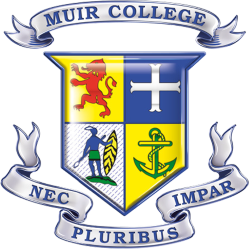Muir College
200 Years Short
Muir College
200 Years Medium
Muir College
200 Years Long
Muir College: Moulding Boys Into Gentlemen Since 1822
Oldest Boys High School in South Africa
Post Founders’ Week 2022 OMU Newsletter, 3rd Quarter
Of the single-sex schools that currently exist, Muir College is the oldest English-speaking boys’ high school in South Africa, tracing its origin back to 1822, when a Scottish educationalist, James Rose Innes established Uitenhage’s first Government Free School in a house in Cuyler Street in October 1822 with 60 pupils, both boys and girls.
In 1865 the Proprietary School – more exclusive and fee-paying – opened. The Rev. Robert Templeton M.A. was the headmaster of the Proprietary School. When Templeton left Uitenhage at the end of 1866 to take up a position in Bedford, the Proprietary School was absorbed into the Free School under its principal, Mr John Gibson.
At the end of 1872 the principal of the Uitenhage Free School, Mr John Gibson, retired after 32 years. The Free School was thus ‘abolished’ on 1 Jan 1873 under the Education Act of 1865 and the Uitenhage Undenominational Public School was opened in its place under Mr Brice.
This change of name is linked to the Education Act of 1865, which changed how schools were funded. Basically, because the Government Free Schools were 100% funded by the Colonial Government, they were becoming a financial burden to the state. They were also largely unsuccessful because the colonists were mostly Dutch-speaking and resented the fact that English was made the language of instruction. Uitenhage was an exception, because Rose Innes believed in mother-tongue education and so he retained Dutch as a subject. The School thus enjoyed the support of both English- and Dutch-speaking parents.
The application of the Education Act was based on all Government Free Schools first being legally ‘removed’ from the Establishment before the new funding model was applied. All Established Government Free Schools were therefore technically ‘closed’ on the resignation, retirement, death or dismissal of the principal, followed by the re-registration of the school as a state-aided non-denominational (in other words not linked to or administered by any church) public school. This ‘closure’ therefore mostly did not mean the complete end of a school – rather it was a re-classification process that allowed for the re-opening of a school on a different financial and management model, under a new principal, but often in the same building with the same pupils.
In 1873 the school became a boys’ only school and this led in turn to the opening of our sister school, Riebeek College for Girls in 1877. In 1875 the school moved to Park Avenue. During 1892 the Public School’s name changed to the Muir Academy in honour of the new Superintendent-General of Education, Sir Thomas Muir. In 1906 a new school building was opened on the Park Avenue site (Old Red Brick Building) by Dr Muir. The school was known as Muir High School, however by 1907 the school was known as Muir College.
In 1962 Muir Primary moved to separate premises. Muir College moved to Vanes Estate in 1987 and Muir Primary moved back into the Park Avenue buildings. The Senior and Primary schools amalgamated in 1994 and now occupy the Vanes Estate site. Boarding facilities for approximately 100 pupils are also situated on the Vanes Estate campus.
The school badge had its origin with the Proprietary School in 1864 and shows the Rampant Lion of Scotland in the left quadrant, which honoured the Scottish headmaster. Facing it is the Cross from Uitenhage’s coat of arms (from the founder of Uitenhage), General J. Uitenhage de Mist’s family crest. Below is the Xhosa Warrior, which represents the Eastern Cape. This figure appears on the seal of the proposed Eastern Cape Colony. Although the division of the Cape Colony into East and West did not occur, a seal was prepared and is on view in the Cuyler Manor Museum. The last quadrant shows the Anchor, representing the Cape Colony.
We are supported in this by the extensive research done on the histories of the Cape’s early schools by the Centre for Conservation Education and Education Museum in Wynberg, Cape Town. Their information is based on 10 years of more recent research done by Ms Sigi Howes using primary sources such as the Educational Returns contained in the Government Blue Books, Inspection Reports & the Education Gazettes, and also scrutinising how the Education Act of 1865 was applied to schools.
SA History Online also tells us that “In 1839 an Education Department was established at the Cape with a superintendent, James Rose Innes, at its head. Innes was the 22-year-old schoolmaster who established the school in Uitenhage in 1822 that was to become Muir College, named after one of Innes’s successors as Cape Superintendent-General of Education, Dr Thomas Muir (later Sir Thomas)”.
We thus have proof that shows quite clearly that there has been continuity from 1822 to the present day. There have been periodic changes in the status, the location, and the pupils, but in every instance only one of these elements changed – e.g. to a new building, or from an entirely free school to a partially fee-paying school. The biggest change came in the 1870s – due to the Education Act of 1865 (Nr 13) – when it was converted to a Public School which allowed the school to develop and grow into the school it is today.
In this spirit, Muir College stands by its 1822 foundation date and will proudly celebrate 200 years of good education and of moulding boys into gentlemen.



























